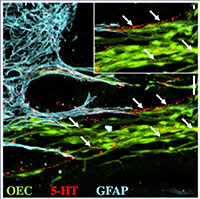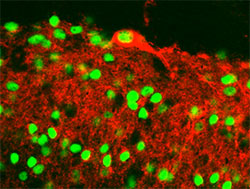 |
 |
 |
|---|
 |
 |
 |
|---|
Spinal Cord Injury: Therapeutic Effect of Olfactory Ensheathing Cell Transplantation
Spinal Cord Development: The Role of Reelin Signaling in Neuronal Migration Developmental studies in the lab focus on neuronal migration in the dorsal horn of the A major focus in the lab is to determine the cells and molecules that facilitate axonal
regeneration after spinal cord injury. For a number of years we have studied the effects of
olfactory ensheathing glial cell (OEC) transplantation following spinal cord injury. OECs are
known to associate with olfactory receptor neurons that are generated throughout life and
continually project their axons from the PNS (nose) into the CNS (olfactory bulb). Dr. Phelps
and her students, in collaboration with the Edgerton Lab at UCLA, found that the
transplantation of OECs above and below a complete spinal cord transection promotes axon
regeneration and results in electrophysiological, anatomical, and behavioral changes in
hindlimb function. Such findings suggest that OECs promote regeneration of mature axons and
the reorganization of spinal circuitry, both of which contribute to sensorimotor function.
Further, we have analyzed the effects of OEC transplantation on anatomical changes during the
acute and chronic injury phases. Another aspect of the OEC project involves the use of in
vitro injury models in which we showed that OECs promote axon regeneration on an inhibitory
substrate by the secretion of brain-derived neurotrophic factor, and promote neurite
outgrowth by direct cell-to-cell interactions.
A major focus in the lab is to determine the cells and molecules that facilitate axonal
regeneration after spinal cord injury. For a number of years we have studied the effects of
olfactory ensheathing glial cell (OEC) transplantation following spinal cord injury. OECs are
known to associate with olfactory receptor neurons that are generated throughout life and
continually project their axons from the PNS (nose) into the CNS (olfactory bulb). Dr. Phelps
and her students, in collaboration with the Edgerton Lab at UCLA, found that the
transplantation of OECs above and below a complete spinal cord transection promotes axon
regeneration and results in electrophysiological, anatomical, and behavioral changes in
hindlimb function. Such findings suggest that OECs promote regeneration of mature axons and
the reorganization of spinal circuitry, both of which contribute to sensorimotor function.
Further, we have analyzed the effects of OEC transplantation on anatomical changes during the
acute and chronic injury phases. Another aspect of the OEC project involves the use of in
vitro injury models in which we showed that OECs promote axon regeneration on an inhibitory
substrate by the secretion of brain-derived neurotrophic factor, and promote neurite
outgrowth by direct cell-to-cell interactions.
 reeler spinal cord. Reelin, the protein absent in naturally occurring reeler mutants, is a
large extracellular matrix molecule that binds to lipoprotein receptors (Vldl and Apoer2).
Reelin signaling causes tyrosine phosphorylation of an intracellular adaptor protein
Disabled-1, which then initiates a cascade of events that lead to correct neuronal
positioning. We found that the loss of Reelin signaling causes hypersensitivity to thermal
nociception and insensitivity to mechanical stimulation. Current experiments focus on
dissecting the cellular defects that underlie this unusual combination of nociceptive
defects.
reeler spinal cord. Reelin, the protein absent in naturally occurring reeler mutants, is a
large extracellular matrix molecule that binds to lipoprotein receptors (Vldl and Apoer2).
Reelin signaling causes tyrosine phosphorylation of an intracellular adaptor protein
Disabled-1, which then initiates a cascade of events that lead to correct neuronal
positioning. We found that the loss of Reelin signaling causes hypersensitivity to thermal
nociception and insensitivity to mechanical stimulation. Current experiments focus on
dissecting the cellular defects that underlie this unusual combination of nociceptive
defects.